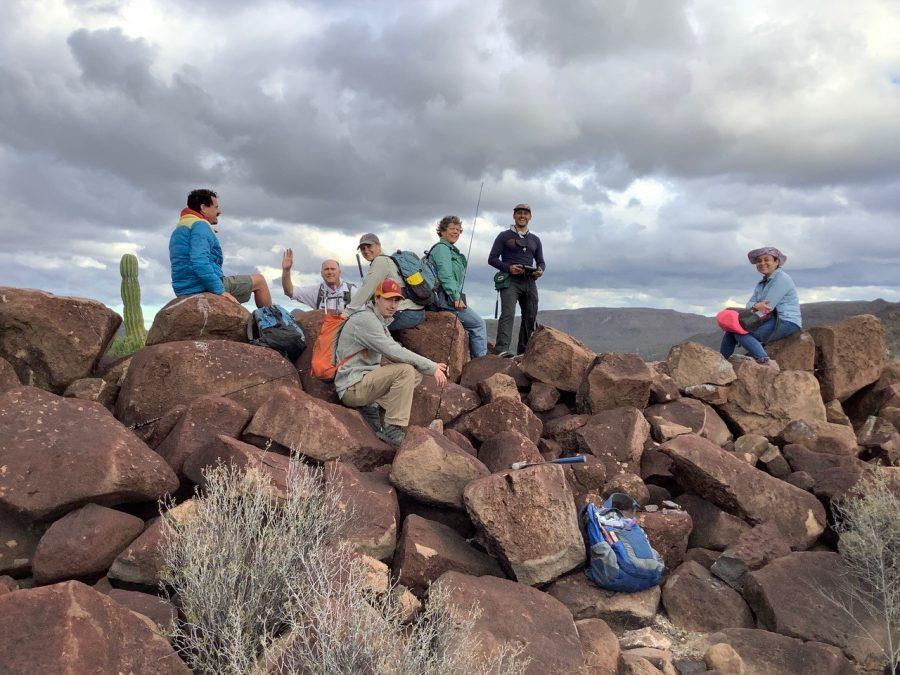A group of researchers arrive at a rocky outcrop. Several geologists jump out of the car and excitedly run toward the stones, tools in hand. The biologists follow, hunting about and asking among themselves, “Are there any lizards around?”
This occurred on the Baja Peninsula during a research outing for a newly funded project that connects scientists from different disciplines. Greer Dolby, an assistant research professor at Arizona State University and a principal investigator for the research project, described the scene with a laugh.
It was like a “comedy to see us all out in the field together,” Dolby said.
Dolby is part of a transdisciplinary research team studying the genetic differences between northern and southern species native to the Baja California Peninsula.
According to Dolby, the research team is made up of biologists, geologists and even a few physicists, and the principle investigators come from four different universities: stratigrapher Becky Dorsey from the University of Oregon, biologist Benjamin Wilder from the University of Arizona, biologist Dolby from ASU and volcanologist Brian Hausback from California State University.
The project was born out of a group called the Next Generation Sonoran Desert Researchers, or N-Gen, which is a community of scientists from both the U.S. and Mexico that includes researchers from many disciplines focused on studying the Sonoran Desert, according to Wilder.
“This is a collaborative team that we’ve been working toward … since 2012,” said Wilder, director of the Desert Laboratory on Tumamoc Hill and director of N-Gen. “This was the third iteration of our proposal.”
According to Wilder, this third try was actually the group’s last chance to receive funding.
Finally, in May 2019 they were awarded a $2.6 million grant from the National Science Foundation to conduct their study over a five-year time period, Dolby said. The team began their research in August 2019.
RELATED: High precipitation years won’t save trees from affects of climate change, study finds
The study aims to determine the cause of genetic distinction between northern and southern species on the Baja Peninsula. In other words, an animal from the northern portion of the peninsula will be genetically different from its southern counterpart despite looking the same on the surface. According to Wilder, this phenomenon is known as cryptic vicariance.
“Species don’t – in real life – they don’t often confine themselves to these nice little boxes,” Wilder said. “[Species] are in the process of diversifying or coming together. … These really clear boundaries that you make between species don’t often hold in the field.”
The team has three hypotheses to explain the genetic divergence between northern and southern populations, which they titled in their project summary “Mid-peninsular Seaway Hypothesis,” “Glacial Refugia Hypothesis” and “Rainfall Asynchrony Hypothesis.”
Overall, the genetic divergence occurred because the species in the north and the south did not reproduce with each other over a period of time, according to Dolby. However, exactly what caused this to happen is what these researchers are aiming to uncover.
The Mid-peninsular Seaway Hypothesis theorizes that there was once a canal that bisected the Baja Peninsula and prevented northern and southern species from reproducing with one another. According to head principle investigator Dorsey, there is substantial evidence to support the hypothesis.
“Possibly our most important discovery so far was the finding of tidal and marginal to shallow marine deposits that are in the same age range as the previously inferred cross-peninsular seaway,” Dorsey said in an email. “It means we have preliminary evidence for an actual geological barrier, which is exactly what we were looking for.”
The second hypothesis, the Glacial Refugia Hypothesis, bases in a 100,000-year cycle of glacial periods shifting the habitats of species by forcing them to take refuge in mountainous areas.
“The reason that that matters for the peninsula is that the mountains happen to be in the north and in the south,” Dolby said.
Finally, the Rainfall Asynchrony Hypothesis proposes that the differing rainy seasons in the north versus the south of the peninsula cause northern species and southern species to mate at different times of the year.
“In the southern part of the peninsula, it mostly rains in the summer via monsoon processes,” Dolby said, “and in the northern part of the peninsula, it mostly rains in winter. … There’s a lot of behavioral processes … that may be tied to when water is available.”
However, Dolby, Dorsey and Wilder all said there may be more than one of the hypotheses at work.
“The thing that I think is pretty cool about this project is … we’re actually going into it assuming that multiple of these things, these causations, are actually happening,” Wilder said. “To try to pigeonhole ourselves into one option or the other is just unrealistic.”
What makes this research so important, according to Dorsey, is its venturing into a new discipline.
“We are working as a team at the cutting edge of the new field called geogenomics,” Dorsey said via email. “It is exciting to work with such an outstanding group of scientists who share a vision of teamwork and collaboration in this emerging new discipline.”
Dolby said the project was also unique in that it is connecting two fields that don’t often mingle to foster a more complete perspective.
“It was just really formative to realize that [biology and geology] are not often studied together and yet they are both co-occurring and interrelated,” Dolby said, referring to her time as an undergraduate studying both fields.
Dolby described the intermingling of these two fields as “beautiful.”
“I think there’s so much to tackle there that would give us a really profound, different view of how these two systems,” Dolby said, “the physical system and the biological system, coevolve over time.”
Follow Sam Burdette on Twitter









